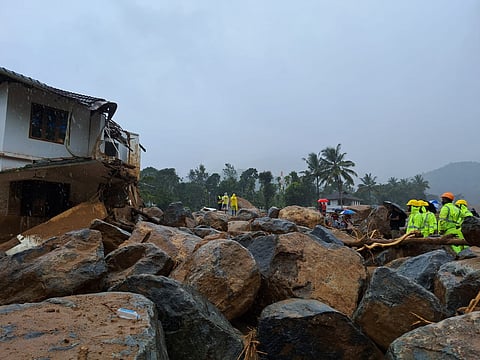

The rainfall that Wayanad received on a single-day – July 30, 2024 – triggering multiple devastating landslides was historically Kerala’s third heaviest and is linked to human-induced climate change, says a study by the World Weather Attribution (WWA).
Northern Kerala, which includes the district of Wayanad, received more than 140 mm of rain in a single day—equivalent to nearly a quarter of London’s annual rainfall. The July 30, 2024 rainfall that triggered landslides in Mundakkai and Chooralmala in Meppadi, claiming over 230 lives and obliterated human habitats, was historically Kerala’s third heaviest in the JJAS (June, July, August, September) season, it said.
WWA is an international initiative to analyse and communicate the influence of climate change on extreme weather events including rainfall and heat waves with help from scientists. The study was jointly conducted by researchers from four countries— the United States, the United Kingdom, Sweden and India.
The heaviest 1-day rainfall events seen by Kerala happened in 2019 (209mm) and 1924 (190mm), found the study, said Sam Fraser-Baxter, Communications Manager, WWA. Researchers analysed historic rainfall data from the Indian Meteorological Department (IMD) and Climate Prediction Centre (CPC).
The July 30 rainfall surpassed the single-day rain Kerala received in 2018. An event of such magnitude is expected to occur about once every 50 years, the study said. The analysis also found that single-day monsoon downpours in Wayanad are currently 10% heavier than the pre-industrial (1850-1900) period.
For the study, researchers averaged the daily rainfall data for the districts of Kasargod, Kannur, Wayanad, Kozhikode, Malappuram, Palakkad and Thrissur and parts of Ernakulam and Idukki.
Based on the climate model predictions, the report discussed the relationship between climate change and the intensity of rainfall events. The earth is now 1.3°C warmer than it would have been at the beginning of the industrial period. “The available climate models indicate a 10% increase in intensity. Under a future warming scenario where the global temperature is 2°C higher than pre-industrial levels, climate models predict even heavier one-day rainfall events,’ said the study. A warmer atmosphere, heated by fossil fuel emissions, can hold more moisture, resulting in heavier downpours. “If the world does not move away from fossil fuels, causing global warming to reach 2°C, one-day spells of rainfall in Kerala will become a further 4% heavier, risking even more destructive landslides,” the study said.
Deforestation is the most pronounced land-use change in the district. Between 1950 and 2018, Wayanad lost 62% of its green cover, with tea plantation areas increasing by approximately 1800%, resulting in reduced forest cover.
The increase in climate change-driven rainfall is likely to increase the potential number of landslides in the future, raising the need for adaptation actions that may include the reinforcement of susceptible slopes, landslide early warning systems, and construction of retaining structures to protect vulnerable localities.
“In addition, draining solutions as well as retaining walls can be constructed to reduce landslide risks, and awareness can be raised amongst local people to avoid construction near or along drainage paths or at the top or base of landslide prone areas,” it said.